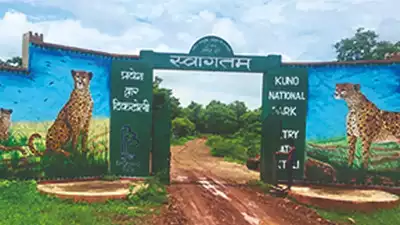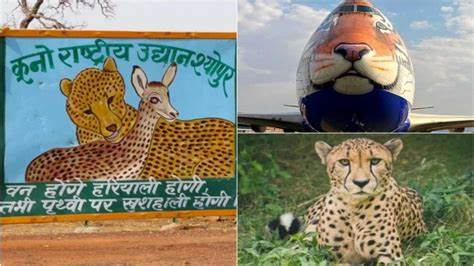To see Cheetahs from Namibia in Kuno National Park, then definitely make a plan to go here, reach like this
Kuno National Park :-
Kuno National Park was very much discussed in the past. The reason for this was the release of cheetahs brought from Namibia in this park. This work was done on the occasion of the birthday of P.M. Narendra Modi. However, there is a big difference in the temperature, climate, environment of Namibia and Kuno National Park. In such a situation, the question also arises whether these foreign cheetahs will be able to survive here. Well, if you want to see these cheetahs, then for this you have to go to Madhya Pradesh, because this park is located here. Let us know some special things about Kuno National Park.


Where is Kuno National Park?
Kuno National Park is located in the state of Madhya Pradesh. It was included in the list of National Parks of the country in the year 2018. Kuno National Park was established in the year 1981 as a wild sanctuary. It extends to Sheopur and Morena districts of Madhya Pradesh. In the year 2009, this sanctuary was also proposed as a potential site for the resettlement of cheetahs. Male and female cheetahs were brought here from Namibia on 17 September 2022. This is the first Cheetah Sanctuary in the country.
What to see in Coono National Park.
This sanctuary was converted into a national park in the year 2018. This park is spread over an area of about 900 square kilometres. If you are planning to visit here, then you will get to see many types of animals. Here one can see cheetah, jackal, deer, nilgai, chinkara, big-horned antelope, wild boar, wolf, monkey, sambar, beautiful deer, leopard etc. from close quarters. Kids will love this place. The special thing is that Ranthambore National Park is located just 100 km away from this park, where tourists like to go a lot. Here also you will get to see animals like tigers, lions, cheetahs etc.
 |
| Kuno National Park |
How to Reach Kuno National Park ?
If you want to see this National Park, then you can also reach here by rail, road, air. The nearest airport to reach here in MP is Gwalior. Morena is about 30 kms from here. If you are going by train, then you can go to Morena, Bhind district by train. You can also reach all these districts by bus. You can also reach here by booking a personal car or vehicle.
Kuno National Park in Madhya Pradesh is considered to be the most unique and picturesque destination for all wildlife lovers and enthusiasts. As soon as they enter the park, they experience unique forests of Kardhai, Kher and Salai and vast open grasslands where many can see wildlife from all around. Some of the grasslands here are bigger than Kanha or Bandhavgarh Tiger Reserve.

It is also believed that the abundance of kardai trees here turns green even before the arrival of the first monsoon rains with the presence of moisture in the atmosphere. In many ways it represents the true spirit of Kuno - the never-say-die attitude and ability to survive and ultimately grow despite the many challenges this forest has overcome.
The Kuno area, now a national park, began as a sanctuary of about 350 square kilometers. And the Kuno River was in the shape of a leaf with a main center spine structure. The river not only helps maintain a constant supply of water in the area and irrigates the forest from within but also gives the protected area its name. One of the preconditions raised by the concerned authorities regarding the status of this protected area was to upgrade it to a national park while another was added because the Asiatic Lion Recovery Project has been going on for some time and the sanctuary is not suitable for housing lions. It is about 400 sq km and is now an ancient forest area of 748 sq km. The park is located in Mota Kuno Wildlife Division with a total area of 1235 sq km.
Also reade...,
Special Educators requirements 2022 Government of Gujarat
History
Kuno National Park/Kuno Wildlife Division and the surrounding area have historically been rich in wildlife. This area was known as dense forest even in ancient times. A gazette of the Gwalior kingdom of 1902 records that the Mughal emperor Akbar captured a large herd of elephants in the forests near Shivpuri in 1564 while returning from the Malwa region. Abul Fazl also mentioned the fact that lions were seen here. This region and the last lion from this region is known to have been shot near Guna city in 1872.
The history of Kuno is intricately interwoven with the history of lions and the various attempts to relocate lions in some capacity or other from time to time in the area. It is impossible to talk about the history of this place without mentioning the lions and their translocation efforts.
In the year 1904, Lord Curzon was invited by the then King of Gwalior, Madhavrao Scindia, for a hunt. Lord Curzon was so impressed with the Kunoni valley forest that he immediately suggested the king to bring lions from Junagadh, Gir and release them in the forest. Raja Sindhia began to act on it with a boldness befitting a Maharaja and tried to co-operate with the Nawab of Junagadh at his level. During that time he built a large enclosure at Dob Kund as the lions were bound for acclimatization before being released into the wild. However, his initial efforts went in vain. Lord Curzon also tried to help by facilitating talks with the Nawab and personally involved in the transfer but the Nawad continued to delay the project.
Later Lord Curzon also presented the king with a letter addressed to the ruler of Abyssinia (present day Ethiopia) to bring some lions from there to Kuno. D.M. A Persian expert named Jhal was entrusted with the project by the king and in 1905 the project was completed at a cost of Rs. 1 lakh budget in that year. With the King's support, Mr. Jal managed to bring 10 lions from Africa. However, three of them died by the time they reached Bombay Harbour. Of the 7 lions that survived, 3 were males while the remaining 4 were females and were welcomed by the king himself. He named the males Bunde, Banke and Majnu and the females Ramaili, Rampyari, Bijli and Gendi. These lions were later released in the forests of Shivpuri instead of Kuno. Unfortunately these lions became cattle raiders and cannibals between the years 1910 to 1912 and the project failed due to this unfortunate turn of events. Although the king's dream of seeing lions once again thrive in this landscape did not materialize in the way he had envisioned, his efforts were bold and successful to say the least.
The area surrounding Kuno river has been rich in biodiversity since ancient times. Its importance can be reflected in the 30,000-year-old cave paintings in nearby Pahargarh depicting multiple wild animal.
Also read...,
Tirupati Venkateswara Temple (Hindu temple) Aandhrapradesh India
Tirupati Venkateswara Temple (Hindu temple) Aandhrapradesh India
Government of Madhya Pradesh realising the significance of this place established the Kuno Wildlife Sanctuary of about 345 square km in 1981 within a larger forest area of approximately 3300 square km. To further strengthen the Wildlife conservation and ensure proper management of this area an additional approx. 891 square km was later added as the buffer to establish the Kuno Wildlife Division of 1235 square km in 2002.
Biogeographically this area falls under the Kathiawar-Gir dry deciduous forest eco-region and the forest types found in this area include the Northern tropical dry deciduous forest, Southern tropical dry deciduous forest, Dry Savannah forest & grassland, Tropical riverine forest. It is equally rich in the faunal species and thus provide a rare amalgamation of various favourable factors for wildlife. The significance of this area is strengthened by the fact that because of its aptness on various parameters Wildlife Institute of India chose this as the most suitable location for Lion Reintroduction Program in its study.
Once the area was identified as the most suitable locations for the reintroduction of Asiatic Lion, the then management started making long term focussed efforts to improve this area as per the requirement beginning with relocating the villages from inside the park to place which is more beneficial to the residents of those villages as well as beneficial to the denizens of the forests. 24 villages were relocated outside the sanctuary from 1998 to 2003 and about 6258 hectare area was made available.
With consistent and determined efforts of the management body of the park, relocation of villages resulting in reduced biotic pressure and improvement in the floral, faunal and avifaunal density in the park , Government of Madhya Pradesh revised the status of this area, ameliorating it to become a National Park with 748.761 square km as the core and 557.278 buffer area as the buffer in December 2018. This upgradation of Kuno Sanctuary to Kuno National Park further cements it’s importance in the field of Wildlife Conservation in Central Indian Landscape.
Important link
Tags:
Government of India
